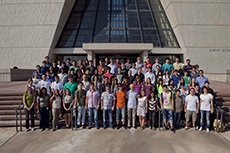Summer students get a taste of particle physics research through Fermilab internships
 |
Summer 2012 student interns pose in front of Wilson Hall. Photo: Cindy Arnold
|
Summer at Fermilab brings sun, greenery and plenty of outdoor activities.
Summer also brings more than 90 students from U.S. high schools and universities worldwide to participate in Fermilab's many summer student internship programs.
The programs, each of which has between six and 20 students, are a way for high-school students and undergraduates to put their knowledge of research methods to practice in a real laboratory environment, said Education Office Program Leader Spencer Pasero.
"Being in a lab situation can really change the students' expectations," Pasero said. "This is in many ways different from a university research environment."
The students spend 10 weeks working on projects ranging from constructing small pieces of machinery to computer-based data analysis. They are placed in nearly all experiments and divisions at Fermilab, from the Technical Division to groups on experiments such as CDF.
Additionally, project mentors are assigned to guide individual students through their day-to-day tasks and long-term research goals.
Students can come from around the world. Present and past students have come from Cuba, Italy, Mongolia and Russia. High-school, community college and university students come from all over the United States as well.
"I'm mainly here for the experience," said James Sebald, an undergraduate from the University of Wisconsin-Madison who is working this summer on the Holometer, a project that may be able to measure whether or not space-time is quantized.
Sebald is involved in research at his university but said he chose the Fermilab summer internship because of the international community and the chance to be a part of discovering new physics.
Erik Ramberg, co-manager of the Science Undergraduate Laboratory Internship and the Internships for Physics Majors, agrees that working in a lab setting gives students a real taste of the research life.
"University research is more broad, but here the students can focus on particle physics," Ramberg said. "Some students can work on high-energy colliders and, at the same time, others can be doing searches for dark matter. But it all falls under the umbrella of particle physics."
Students present their work at the end of the summer, and mentors have a chance to critique their research and help them improve.
Pasero said the mentors and experiment groups enjoy having young students on their team.
"Experiment groups often tell us how interested the intern is," Pasero said. "We get feedback from the intern and the experiment, so reviews are a two-way street."
The feedback from many past summers of student programs will go into this summer's student work, which promises to be as valuable to the laboratory as it is to the students.
—Sarah Khan
|